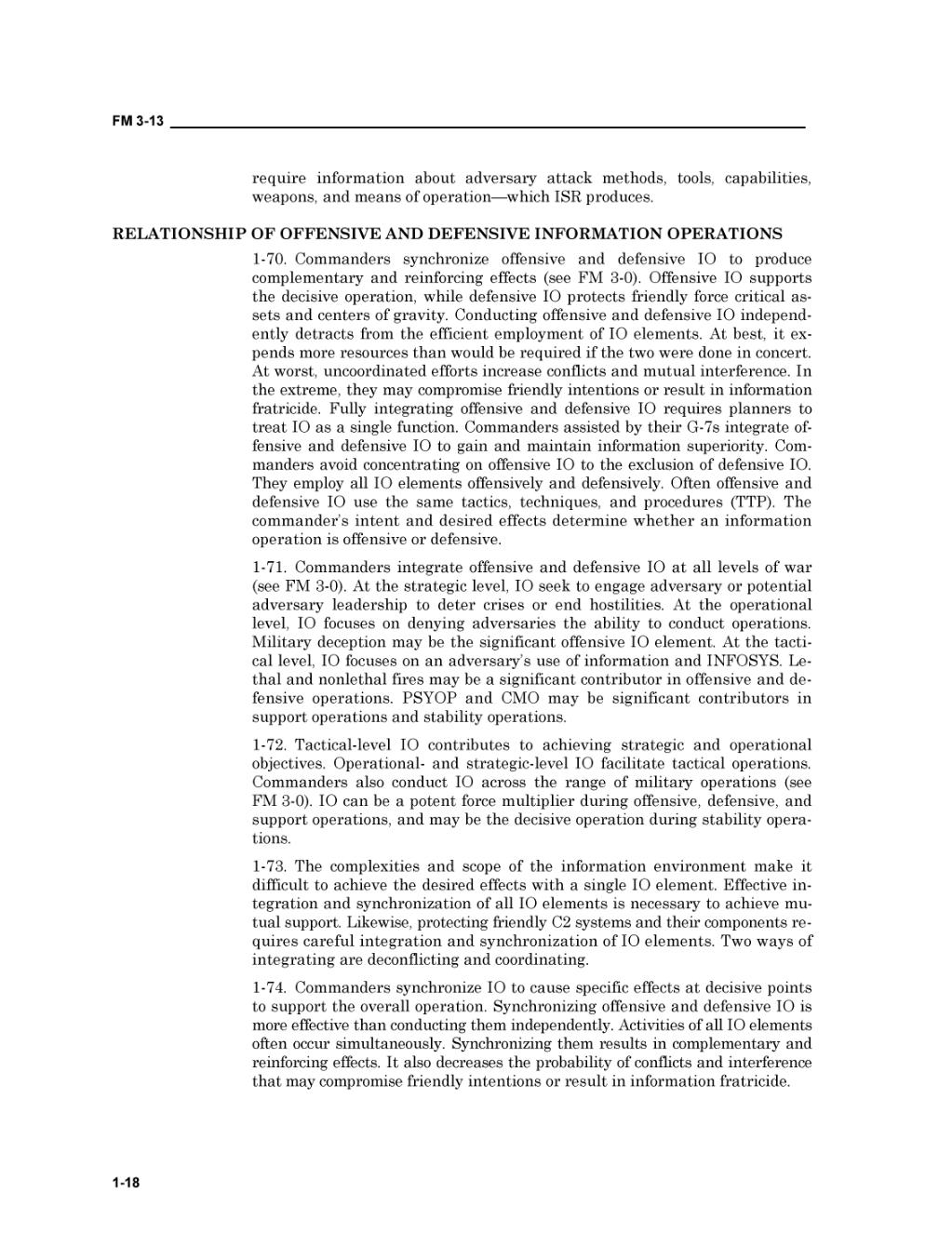FM 3-18 require information about adversary attack methods. tools, capabilities. weapons, and means of operation—wl1iehISR produces. RELATIONSHIP OF OFFENSIVE AND DEFENSIVE INFORMATION OPERATIONS 1-70. Commanders synchmnime otfensive and defensive l0 to produce complementary and reinforcing cftects (sec FM 3-0). Otiensivc I0 supports the decisive opcrutiou, while dclbnsive IO protects friendly time critical as- sets and centers of grnvity. Conducting oficnsive umd delensive XO independ- ently detracts from the ellicient employment of IO elements. At best, it ex— pends more resources than would be required if the two were clone in concert. At worst, unecaordinated efforts increase conflicts and mutual interference. In the extreme. they may compromise friendly intentions or result in infunnation Eatiidde. Fully integrating offensive and defensive IO requires planners to treat IO as a single function. Commanders assisted by their 0-7s integrate eti fensive and detensive 10 to gain and maintain information superiority. Com- manders avoid cuncentmtring on ettensive IO he the exclusion of defensive IO. They employ all IO elements otfertsively and rletensively. Otten otiensivc and defensive IO use the same tactics, techniques, and procedures (TTY). The commanders intent and desired effects determine whether an information operation is offensive or defensive. 1—71, Commanders integrate offensive and defensive IO at all levels of wax (see FM 3—0). At the strategic level, IO seek tn engage adversary or potential adversary leadership to clever crises or end hostilities. At Lhe operational level, l0 focuses on denying adversaries the ability to conduct operations. Military deception may he the significant oftensive IO element. At the tacti- eul level, IO focuses on an zxdvcrsaiys use uf intormntion und INFDSYS. Le» thai und nonlethnl tires may he si significant contributor in offensive and dev funsivc operations. PSYOP and CMO may be signiiiuant contributors in support operations and stability operations. l—72. Tactical-level IO contributes to achieving strategic and operational objectives. Operational- and strat»egic—levcl 10 thcilitste tucticul operations. Commanders also conduct IO across the range of military operations (see FM 3-0). IO can he zi potent force multiplier during otiensive, defensive, und support operations, and may he the decisive operation during stability operw tions. 1—73. The complexities and scope of the lnibrmation environment make it ditiicolt to achieve the desired effects with s single IO element. Etiective in» tegrntion and synchronization ofall IO elements is necessary to achieve mw tual suppoim Likewise, protecting friendly C2 systems and their components ru- quires careful integration and synclironization of l0 elements, 'l’wo ways of integrating are deeonflicting and coordinating. 1/14. Commanders synchronize IO to ennse speciiie etiects at cledsive points to support the overall operation. Synchronizing oiitensive and defensive l0 is more utfective than conductin;-r them independently. Activities of all I0 elements often owur simultaneously, Synchzonizing Lliein insults in ooniplemcntary and reinforcing eiiects. It also decreases the probability of conflicts and iotertcrunce that may compromise iriuudly intentions or result in iniorrnation Bmsicide. 1·1H
